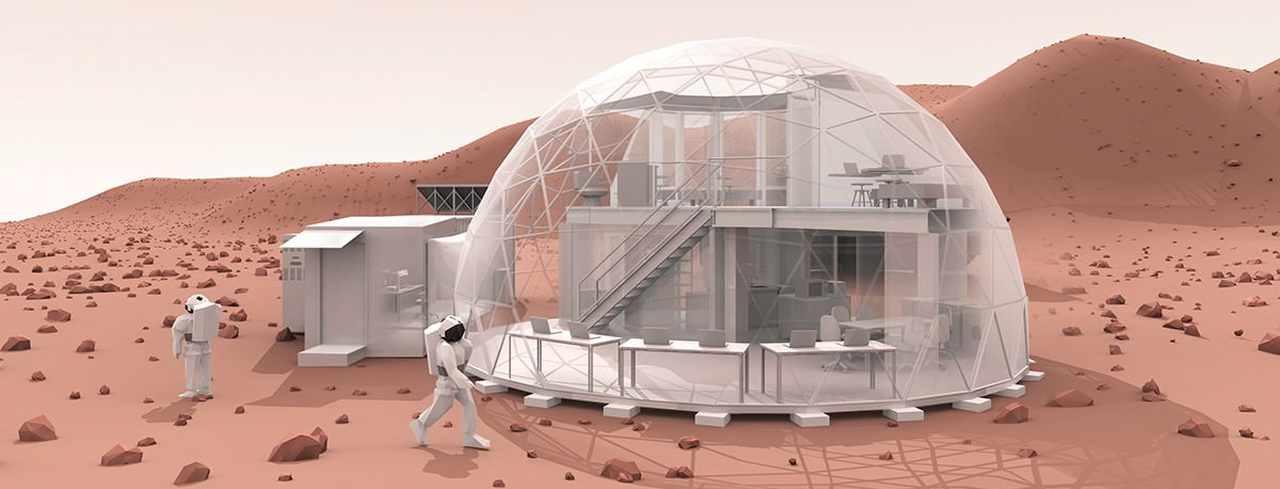Space architecture
After the exploration of earth, humans desire to explore space

What makes humans different from any other species in the world is their curiosity and the urge to break the barriers of impossibilities. After the exploration of earth, humans desire to explore space and create another planet earth to increase the chance of survival from another mass extinction just like Dinosaurs. Space architecture is a study and practice of designing habitable spaces in outer space. The study includes physiology, psychology, and sociology along with architecture and engineering. The main challenge for space architects is outer space which is full of cosmic radiation and extreme weather conditions which makes the space inhabitable.
It’s over 50 years since we have landed on the moon, and we have launched 8,900 satellites to outer space to study space closely. In the last few decades, we have landed unmanned robots to study Mars and search for life. Since then, space architecture too evolved from designing rocket capsules, space shuttles, space vehicles, habitable capsules, and many more. One of the biggest achievements of space architecture to date is the International Space Station (ISS). Astronauts have been able to live in ISS for almost 2 years, orbiting around the earth and studying outer space closely. Along with further exploration in outer space, space architecture aims to build habitable spaces in Moon, Mars, Venus and start Space Tourism in few decades. Several space organizations like SpaceX, NASA, Blue Origin, etc are highly funded ventures to create new heights in the space race.
Timeline showing the development of space architecture.
1865 – “From Earth to the Moon” by Jules Verne was published. It was a science fiction story in which several details of space missions were included and explored. The details included no: of crew limited to three, spacecraft dimensions, use of collapsing telescopes, oxygen generators, firearms, and agriculture in space.
1903 – Konstantin Tsiolkovsky published the first theoretical journal of space travel. Concepts like space elevators, rotating space stations to create artificial gravity, airlocks, space suits, closed ecosystem, etc were introduced.
1952 – Wernher von Braun published about inhabitation on space station concept and several mission plans in a series of magazine articles. He first illustrated the spinning space station which included three decks for navigation, meteorological stations, earth observation, military platform, and other possible explorations.
The 1960’s – In this period, architects and industrial designers started actively participating in the aerospace industry.
12 October 1964 – Voskhod spacecraft carried the crewed flight of the Soviet Space Program.
1966-1972 – Apollo Space Program – In this period, the first crewed flight to the moon (October 11, 1968) and humanity’s first step to the moon (Jul 20, 1969) took place and was live broadcasted on television around the world.
23 April 1967 – Soyuz 1 carried the crewed flight of Soviet Space Program replacing Voskhod spacecraft.
1971 – The studio of Vladimir Chelomei designed Salyut 1 and was launched in USSR.
1973 – Industrial designer Raymond Loewy helped NASA to include a window in the space station to look outside for the first US Space Station Skylab. Skylab was launched in May 1973. It got decayed and disintegrated on July 11, 1979.
1981 – Space Shuttle Program – Space shuttle is a low Earth orbital spacecraft used by NASA from 1981-2011. Five space shuttles were completely built and have completed 135 missions. The missions included the launch of several satellites, Hubble Space Telescope (HST), participation in the Shuttle-Mir Program with Russia, and construction of ISS.
1986 – Mir Space Station – Mir was a low Earth orbit space station that was operated by the Soviet Union and later by Russia. It operated from 1986 to 1996. The space station acted as a microgravity research laboratory to develop technologies for space inhabitation.
1998 – International Space Station (ISS)- ISS is a modular habitable space station in low Earth orbit. It is a collaborative project of five space agencies- NASA, Roscosmos, JAXA, ESA, and CSA. ISS serves as a microgravity laboratory and space research laboratory. ISS is mainly divided into two parts: ROS (controlled by Russia) and USOS (controlled by the United States). ISS consists of docking ports, experimental bays, robotic arms, habitable modules, etc.
1999 – Shenzhou Spacecraft – This spacecraft is made for a crewed spaceflight program that is designed and operated by China. It consists of three modules: the orbiter module, re-entry module, and aft service module. On 15 October 2003, the first crew was launched with Shenzhou 5 mission.
2004 – Vision for Space Exploration (VSE)- It is a plan for space exploration by President George W. Bush. It was made to get public support and interest for space exploration. The plan aims to carry out the crewed mission to Mars by 2020.
2005 – Exploration Systems Architecture Study (ESAS)– It is a branch of the study of large-scale and system-level study by NASA. It was officially declared after the VSE plan in 2004.
2012 – Space X Dragon- Space X developed cargo modules and habitable modules and reduced the cost of spaceflight. Now Space X in collaboration with NASA launched several cargoes and helped return astronauts from space.
2014 – Orion MCPV – It is a partially reusable space capsule made by NASA for human spaceflight programs. It has three modules- crew module, European Service module, and Launch Abort System.
SpaceX Starship – It is fully reusable Beyond Earth Orbit space vehicle which is currently under development by Space X. NASA had chosen Starship for a crewed mission to the moon and return to Earth. Starship aims to perform a crewed mission to Mars and develop a self-sustaining research base.
The history of space exploration and the development of space architecture is long and costs billions of dollars. From space, exploration humanity understands the space beyond earth and broke every single barrier they have encountered. Space Architecture is a highly specialized branch that requires costly infrastructure to study. Very few institutes work closely with space agencies and they provide a degree in Space Architecture. Here is the list of institutes where students can study Space Architecture:
1) Sasakawa International Centre for Space Architecture (SICSA)-University of Houston
SICSA offers the world’s only Master of Science (MS) degree in architecture. It has two types of curriculum i.e., one for the full time that comprises of 3 semesters and the other for part-time of 5 semesters. The team comprises academic leaders of space architecture and professional designing at extreme conditions on earth. The institute is also collaborating with NASA, The Boeing Company, Oceaneering, Houston Spaceport, etc for conducting research and other studies. Online lectures and study materials are available on the website for the students to study more space architecture.
2) International Space University (ISU), France
ISU provides a master’s degree in space science, space studies program, short space courses (on-site and remote), the interactive space program, and many more. ISU has sponsors from renowned space agencies and alumni in NASA, SpaceX, etc. Masters in space science (MSS) is a one- or two-year program consisting of studies, thesis, and internship.
3) John D. Odegard School of Aerospace Science, ND
This institute provides masters in Atmospheric Sciences, Aviation, Earth System Science & Policy, and Space Sciences. They have received over 3.5 million dollars for NASA-funded researches and have contributed to the space industry for the last 32 years. The space studies department has 25 students on campus and 100 students at the distance education program.
4) NASA Astrobiology Institute (NAI)
NAI provides information, workshops, short courses, and other studies related to Astrobiology. Understanding astrobiology gives a space architect an edge over extreme life forms and material technology. NAI is also working on evidence of life without oxygen and life on other planets.
5) Keck Institute for Space Studies (KISS)
KISS provides space studies in the form of online and offline lectures, workshops, short courses, etc. KISS has four parts in space studies- Earth, Planetary, Astrophysics, and engineering. KISS’s recent lectures include solar system explorations, COVID-19, Venus exploration, and many more.
Architecture in space is full of challenges. Here is the list of challenges that are faced while designing in space architecture:
- Extreme weather conditions to be considered.
- The space designed must be habitable, easily constructed and delivery model to be planned.
- The capacity of the transportation system to be taken into account.
- Fitting everything like building materials, construction equipment, power generators, fuel, water, gas, food, equipment, workforce to be fitted in one module.
- Deployable mechanisms and lightweight materials must be used.
- Robotic labor that can work in non-pressurized conditions to be used.
- The materials available must be sustainably used, reused, and recycled as much as possible.
Several competitions are being organized around the world to get the ultimate solution to achieve human’s dream to step on mars or form a colony on the moon. The results and the products of these are also feasible for space architecture. The prototypes are being constructed and tested in extreme conditions on earth to solve macro-level problems. Here are some of the products that are being made for space architecture.
A) Mars Ice House- Search/CloudAO
Mars Ice House is a habitat designed for the scientist to stay and research at Mars. Semi-autonomous robots extract the ice from Mars’s surface and build the wall of the Ice House. A translucent layer is formed with a plastic layer is formed which keeps the structure stable. The ice layer protects the habitants from harmful solar rays.

B) Mars Science City- Bjarke Ingels Group
Mars Science City is a prototype building that is proposed by BIG for UAE’s Mars Settlement Vision in 2117. The prototype will be built in few years in the desert of UAE. The construction process will be the same as to be built on Mars. The Science City comprises geodesic domes under which the settlement and plants will be grown. The style of this building is Martian Vernacular Architecture.

C) Marsha- AI Space Factory
Marsha is a habitat designed by AI Space Factory for the first residents on Mars. The structure is an elongated egg-shaped high-rise building. The building is constructed with in-situ resource utilization and semi-autonomous robots. The walls are composed of two layers to fight extreme temperature swings. The semi-autonomous robots with 3D printing technology prints the wall with Martian soil compiled with plastic to form Martian concrete. The habitat has four stories with earthly conditions in it. The prototypes of this building are made with NASA to solve micro-problems.

D) Mars Lab Habitat- SAGA Space Architects
Mars Lab is a simulated Mars Habitat prototype. Lightweight foldable structural systems are made to construct habitable modules. Algae is used to produce oxygen from carbon dioxide and protect habitats from radiation. The prototype is built in the Negev desert of Israel.

With rapid globalization, more people are getting to know about Space Architecture. As a result, competition and quality of the product have increased a lot. Several years back, space explorations looked impossible, but today it is possible. Humans continue to grow as they ask the proper questions and can break every barrier. Space architecture is a growing field that needs more innovative, space enthusiastic people from around the world.
































































